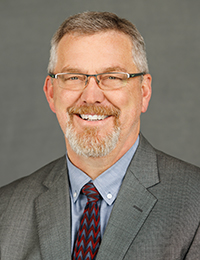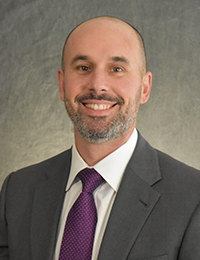feature story
The future of Texas power
September 2024
The challenges of growing energy demand
September 2024 | by Brynne Harder

At a Senate Committee on Business and Commerce hearing in June, chief operating officer of the Electric Reliability Council of Texas (ERCOT) Woody Rickerson testified that investment in the grid would need to exceed recent levels to meet anticipated load growth. In the weeks before, ERCOT released data showing a dramatic increase in Texas’ expected electricity demand.

“Traditionally, load generation and transmission all were built at about the same rate,” explained Rickerson. “But that paradigm is changing now, and we’re seeing large amounts of load — city-size loads — show up in less than a year.”
Considering all power sources, generation can now be built at about the same pace as load growth, according to ERCOT (PDF). That timeline depends on solar and wind generation, which can be built faster but typically in remote areas far from city centers. Transmission, conversely, still takes about three to six years to build (Exhibit 1).

Load is the amount of energy in megawatt hours delivered at any specified point or points on an electric grid system.
Large loads are being added to the grid more quickly and in greater magnitude than previously seen.
Generation is the facility’s production of electricity for the ERCOT system.
Timelines for adding generation vary depending on the power source or type of facility. Renewable energy sources frequently can be built faster than thermal facilities but typically require more investment in transmission infrastructure because they’re geographically dispersed.
Transmission refers to the infrastructure, such as power lines and substations, that deliver power from a generation facility to the end user.
Texas can build transmission more quickly than other parts of the country due to fewer regulations. However, building transmission (PDF), including planning, assessments, rights-of-way acquisition, permitting, construction and other steps, can still take up to six years to complete.
Source: Electric Reliability Council of Texas
“It’s settled that we need more transmission in this state, but I definitely have concerns about overbuilding that transmission system and putting that [cost] on the backs of residential customers,” stated Thomas Gleeson, chairman of the Public Utility Commission of Texas (PUCT). “One of the ways to limit how much transmission you need to build is to be able to put those generating facilities near load pockets.”

Historically, thermal generation has been closer to those load pockets — large cities with high energy demand. ERCOT reported that from 2018 to 2023, more than 7.3 gigawatts (GW) of this source have been retired. Yet, as of March 31, 2024, the interconnection queue for new power sources (PDF) included 15 GW of natural gas of 346 GW planned.
In an attempt to reverse these trends and secure enough dispatchable generation, the 88th Legislature established the Texas Energy Fund, which provides grants and loans for the construction, operation, maintenance and modernization of electric generation facilities. Gleeson said the program has been “hugely successful” following initial interest from potential applicants. The PUCT received (PDF) 72 applications, requesting $24.4 billion to finance 38 GW of dispatchable generation — significantly more than the $5 billion initially allotted. Taking this interest and projected electric demand into consideration, Gov. Greg Abbott and Lt. Gov. Dan Patrick issued a statement saying they would “seek to expand the program to $10 billion as soon as possible.”
The same legislative session created the Jobs, Energy, Technology and Innovation Act — a competitive property tax assistance program between school districts, eligible companies (including those generating dispatchable energy), and the Governor’s office. The Comptroller’s office, a program administrator, lists five applications submitted under this program as of Aug. 6, 2024, none for utility or dispatchable energy projects.
“We know that initial investment is only part of the equation,” said Texas Comptroller Glenn Hegar. “These are long-term investments for these companies, so they must consider the ongoing costs and potential revenues.”
While consumer demand is leading the calls for investment in new infrastructure, repeated power outages have raised questions about the reliability of existing infrastructure (Exhibit 2).
| Year | Total Events |
|---|---|
| 2023 | 62 |
| 2022 | 52 |
| 2021 | 91 |
| 2020 | 48 |
| 2019 | 39 |
| 2018 | 15 |
| 2017 | 14 |
| 2016 | 14 |
| 2015 | 21 |
| 2014 | 20 |
| 2013 | 7 |
| 2012 | 12 |
| 2011 | 24 |
| 2010 | 7 |
| 2009 | 12 |
| 2008 | 15 |
| 2007 | 5 |
| 2006 | 8 |
| 2005 | 5 |
| 2004 | 7 |
| 2003 | 3 |
Note: Data reflect reported electric emergency incidents and disturbances including, but not limited to, power outages and calls to conserve energy resulting from severe weather, suspicious activity or other causes.
Source: Department of Energy Office of Cybersecurity, Energy Security, and Emergency Response
Following Winter Storm Uri in February 2021, when 69 percent of Texans lost power at some point, the Legislature called for various reforms, including guidelines for increasing the reliability of the ERCOT grid. The PUCT established a reliability standard for the ERCOT region, a key requirement of the legislative reforms, this summer.
Pablo Vegas, ERCOT chief executive officer, told the Senate Committee on Business and Commerce the plan is being watched by national groups.
“Having not only the frequency definition for how often outages could occur in a system but adding to that the magnitude of how big those could be and the duration of how long they could be is a very unique triangulation around reliability,” said Vegas.
House Bill 2555, also an outcome of the 88th Legislature, encourages electric providers to submit their own resiliency plans to the PUCT in preparation of severe weather and seek to recover costs. Utilities began filing plans in spring 2024, and the PUCT has 180 days to approve.
In the meantime, storms and other weather events continue to have devastating impacts on businesses and residents. After Hurricane Beryl on July 8, some in the Houston area lost power for more than a week in summer temperatures. About 300 restaurants have since filed a class action suit against CenterPoint Energy for losses in product, revenue and labor. The electric provider is also facing lawsuits filed on behalf of health, beauty and medical businesses as well as area residents. Following the storm, the PUCT launched an investigation into Houston area electric utilities’ preparedness for and response to extreme weather events.
“Texas is the world’s eighth largest economy. That level of economic output requires a lot of reliable energy to support the businesses and residents calling our state home,” said Hegar. “We can’t expect businesses to continue thriving in Texas if there isn’t an electric grid available to serve them.”